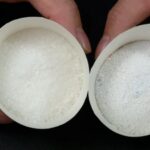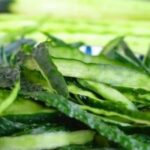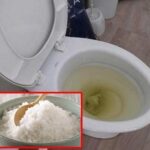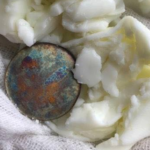1. Removing Ink Stains from Carpet
When ink gets on the carpet, instead of washing the entire carpet, try this trick. Soak a cotton ball in milk and dab it onto the ink stain. Replace the cotton ball frequently to allow the milk to absorb into the carpet. Then, use a sponge dampened with soapy water to blot or vigorously rub the ink stain. Finally, use another sponge or cloth dampened with clean water to wipe the area clean. This quick method will effectively remove the stain.
2. Removing Oil Stains from Books
To remove oil stains from precious books, soak a cotton ball in ammonia (“eau de diable”) and gently rub it onto the oil stain. Then, leave the book in a well-ventilated area to dry.
3. Removing Sugar Stains from Wood
To clean sugar stains from wood surfaces, mix warm water with bran. Use a soft cloth to apply the bran mixture to the sugar stain and wipe it clean.
4. Removing Oil Stains from Wood
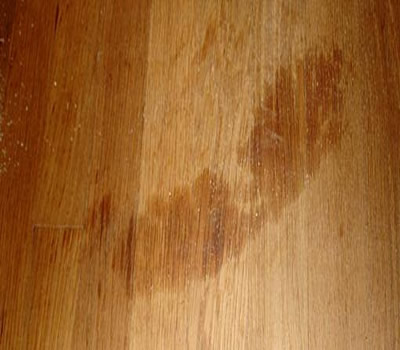
5. Removing Fruit Stains from Metal
To remove fruit stains, as well as stains from vegetables and greens, from metal objects, use ashes to scrub the stain away.
6. Removing Black Stains from Copper
There are many commercial copper cleaners and polishes available in the market. If you don’t have access to these products or prefer a more natural approach, you can use vinegar or lemon juice to remove black stains from copper items.
Cut a lemon in half and dip it in salt. Rub the salted lemon vigorously onto the blackened area. Then, rinse with water and polish the copper with a clean, dry cloth.
Alternatively, you can mix fine sand with vinegar and apply it to the blackened area several times. Afterward, rinse, dry, and polish the copper with a cold, damp cloth. Ensure you use fine sand to avoid scratching the copper.
7. Removing Stains from Silverware
In a pot, mix about 2 liters of water with half a cup of salt. Bring the mixture to a boil and then place your stained silverware into the pot. Let it boil for a while, and the stains will disappear. Afterward, rinse the silverware with clean water.
8. Cleaning White Enamel Tiles

9. Removing Rust Stains from the Sink
Use pure oxalic acid. Dampen the acid with water and sprinkle it onto the rust stains. Newer rust stains will disappear faster than older ones.
10. Removing Stains from Pots and Pans
To remove stubborn stains from pots and pans, sprinkle salt onto the stain and let it sit for a few hours. Then, simply rinse the cookware with clean water.
11. Removing Stains from Glass, Tiles, and Enamel-Coated Surfaces
Vinegar is an effective cleaner for glass, tiles, and enamel-coated surfaces. For tile floors, you can also use a mixture of vinegar and water for cleaning. Alternatively, use a soft cloth dampened with clean water to wipe glass cabinets and display cases. For an even better shine, apply a thick paste of lime or chalk powder to the glass and let it dry before buffing it away with a clean cloth.
12. Removing Stains from Rubber Items
Over time, rubber items can become discolored. To clean them, simply soak the items in boiling water mixed with powdered soap for about 10 minutes. Afterward, wipe them clean with a cloth. Your rubber items will look as good as new.
13. Removing Tree Sap or Fruit Sap from Hands
If you have tree sap or fruit sap stuck on your hands, don’t try to wash it off with soap and water; it won’t work. Instead, use an abrasive stone or pumice stone to scrub the sap away. Follow up by rubbing the area with a slice of fresh lemon, and the sap will be gone.
14. Removing White Water Stains and Dirt from Varnished Wood
Water Stains: If you accidentally place a hot pot or pan on a varnished wood surface (such as a table or sofa), it may leave a white water stain. To remove these stains, use a cloth dampened with paraffin oil to gently rub the affected area. Let it sit for a while, and then apply turpentine oil and buff the surface with a dry cloth.
Dirt: Mix a teaspoon each of salt and cooking oil to form a paste. Apply this paste to the stained area and let it sit for several hours. Then, use a cloth dampened with a mixture of equal parts turpentine and cooking oil to rub away the stain.
15. Removing Grease Stains from Leather

16. Removing Dirt from Leather
If your leather items, such as shoes or bags, have become moldy, you can clean them using a cloth dampened with turpentine oil.
For stubborn or old mold stains, use a very fine-grit sandpaper to gently rub the affected area. Afterward, apply wax to restore shine and color.
17. Removing Insect Eggs from Surfaces
Silverware that is left unused for long periods may develop stains from insect eggs laid by flies, mosquitoes, or other pests. To remove these stains, use a damp cloth dipped in fine salt to rub the stained area repeatedly. Then, rinse the silverware with hot water and soap.
The Magic of Salt: Unlocking the Hidden Power in Your Toilet
When it comes to cleaning your toilet, forget about harsh chemicals. Believe it or not, one of the most effective solutions is sitting right there in your kitchen: salt. Yes, salt is a simple, easy, and affordable way to get your toilet sparkling clean. It’s time to discover the power of this humble kitchen staple and give your bathroom a natural, yet powerful, clean.


























